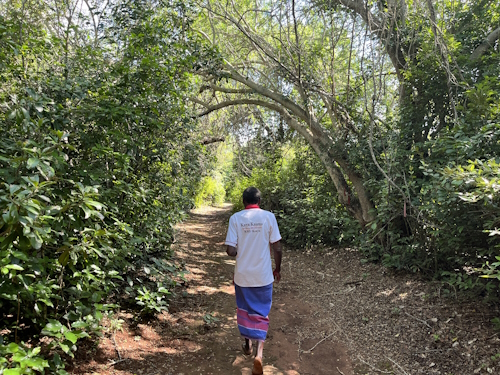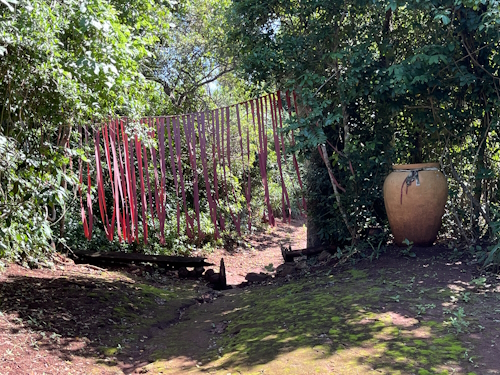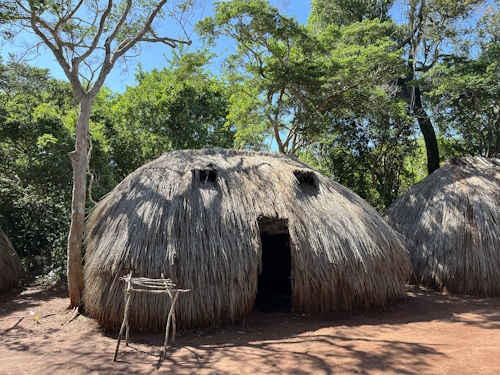Blog WHS Visits
WHS #971: Kaya Forests
The Sacred Mijikenda Kaya Forests along the East Coast of Kenya comprise former fortified settlements (kayas) in an undisturbed forest setting, which still fulfill a sacred role in the belief of Mijikenda peoples. It's such a messy WHS: it is what you get after an AB overrule where the documents haven’t been adjusted to the final decision. When I started preparing for my June 2025 visit, I found out that we had its site history and name (it starts with “Sacred”) all wrong, a rare occurrence nowadays. Originally, it had 36 locations, now there are 8 according to the map section at the UNESCO website, but that’s an error also. Kaya Kinondo was explicitly excluded in the inscription decision. I have alerted the UNESCO WH Bureau to the mistake, but never got a reply and the error persists.
Instead of Kaya Kinondo, which is an easy-to-access site just outside the popular beach resort of Diani Beach, I had to find another Kaya suitable for a visit. All remaining Kayas lie north of Mombasa, so that city or one of the northern coastal towns, such as Watamu, are the best bases. Kaya Kauma stood out immediately as it welcomes visitors regularly as well. I went there on a private half-day tour from Mombasa with Diani Summer Tours.
Kaya Kauma is managed by the Council of Elders of the Kauma people, one of the nine groups that together are known as the Mijikenda. It lies about a 2-hour drive north of Mombasa. My driver started his introduction with “I have never been there, but I have the plan”. Fortunately, he was a persistent guy, because we had barely left the big city when he was called by his contact, the secretary of the Council of Elders. The secretary stated that although a visit was agreed upon beforehand, it wasn’t such a great day as today was a Muslim holiday ánd there had been a death in the village. The driver replied that he had a tourist with him and was coming anyway. Half an hour later, he got another phone call, with the message that the agreed-upon price wasn’t going to do it – the guy from Kauma now demanded 25,000 KSh (about 175 EUR). A ridiculous amount by Kenyan standards, which neither the tour company nor I wanted to pay, but the driver just kept on driving to our target. Later, he got a more reassuring call from another guy from the village near the Kaya (Jaribuni), who said that we could work things out.
The final 12km to the Kaya is on a horrible road that needs a high clearance vehicle and an experienced driver. There’s no signage anywhere, and I guided my driver using Google Maps navigation. In Jaribuni, the local contact hopped in our car and we drove on to the Forest. In the last km, we finally saw a ‘Kaya Kauma – the Sacred Mijikenda Forests’ road sign. We ended up at the edge of the forest where we could park and the Chairperson of the Kaya Kauma Conservation Committee was waiting for us. After a friendly welcome, the financial negotiations restarted. It turned out that the Kauma take a “Bhutanese” approach to tourism: "high-value, low-impact". My driver, who came from Diani Beach, argued that the Kayas in his region (known for mass tourism) are easy to access and against a low fee. The Kauma wanted 25,000 KSh for a visit to the sacred inner area of the Kaya, or 15,000 KSh for a visit to the forest only. I opted for the latter, and we managed to get the price down eventually to 8,000 KSh.
We then followed the Kauma official into the forest. Although all Kayas were made by different groups, they share similar characteristics. One of those is a traditional path, the mwara; usually, there are only two such paths leading to the Kaya. That path first led us past the tree nursery, as the Kauma ‘restock’ the natural forest with plants and trees that bear edible fruits. The forest itself is dense but not very tall. Parts of it are ‘fenced off’ by strips of red cloth. We ended up at the entrance to the sacred area (photo 2), and as agreed, we weren’t allowed to enter. People who may enter have to leave their shoes behind and make an offering in the large jar. The entrance has a whole row of strips of red cloth, plus remains of a stockade that in the past was used to keep strangers out.
Just in front of the entrance is also the (unmarked) burial place for the clan leaders – our guide said that his ancestors were buried there. A side road led us to a clearing in the forest, where the Kaya Kauma Committee now meets. One elderly man lives there permanently. For him and the use of the committee, four formidable straw huts were built in the traditional manner. They have strong doors made of twigs and even ‘windows’. We sat with the man for a while and talked. A visitor's guestbook was produced: for 2025, I was the 6th person to write in the book. I browsed through it but did not recognize any of the names as WH community members. The years 2023 and 2024 didn’t look much busier than 2025, probably some 20 entries a year. So the site is a clear candidate for our ‘1,000 visitors or fewer’ connection. After 1.5 hours, we said goodbye and went on our way back to Mombasa.
All things considered, it was a memorable visit. I’d love to see reviews of other Kayas coming in at this website: how can they be visited and what was the experience?
Els - 8 June 2025


